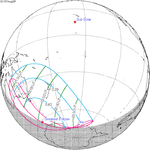Solar eclipse of September 22, 1968
Appearance
| Solar eclipse of September 22, 1968 | |
|---|---|
| Type of eclipse | |
| Nature | Total |
| Gamma | 0.9451 |
| Magnitude | 1.0099 |
| Maximum eclipse | |
| Duration | 40 s (0 min 40 s) |
| Coordinates | 56°12′N 64°00′E / 56.2°N 64°E |
| Max. width of band | 104 km (65 mi) |
| Times (UTC) | |
| Greatest eclipse | 11:18:46 |
| References | |
| Saros | 124 (52 of 73) |
| Catalog # (SE5000) | 9439 |
A total solar eclipse occurred on September 22, 1968. A solar eclipse occurs when the Moon passes between Earth and the Sun, thereby totally or partly obscuring the image of the Sun for a viewer on Earth. A total solar eclipse occurs when the Moon's apparent diameter is larger than the Sun's, blocking all direct sunlight, turning day into darkness. Totality occurs in a narrow path across Earth's surface, with the partial solar eclipse visible over a surrounding region thousands of kilometres wide.
Related eclipses
Solar eclipses of 1968-1971
This eclipse is a member of a semester series. An eclipse in a semester series of solar eclipses repeats approximately every 177 days and 4 hours (a semester) at alternating nodes of the Moon's orbit.[1]
| Solar eclipse series sets from 1968 to 1971 | ||||||
|---|---|---|---|---|---|---|
| Ascending node | Descending node | |||||
| Saros | Map | Gamma | Saros | Map | Gamma | |
| 119 |  1968 March 28 Partial |
−1.03704 | 124 |  1968 September 22 Total |
0.94507 | |
| 129 |  1969 March 18 Annular |
−0.27037 | 134 |  1969 September 11 Annular |
0.22014 | |
| 139 |  1970 March 7 Total |
0.44728 | 144 |  1970 August 31 Annular |
−0.53640 | |
| 149 |  1971 February 25 Partial |
1.11876 | 154 |  1971 August 20 Partial |
−1.26591 | |
| A partial solar eclipse of July 22, 1971 occurs in the next lunar year set. | ||||||
References
- ^ van Gent, R.H. "Solar- and Lunar-Eclipse Predictions from Antiquity to the Present". A Catalogue of Eclipse Cycles. Utrecht University. Retrieved 6 October 2018.
External links
- Earth visibility chart and eclipse statistics Eclipse Predictions by Fred Espenak, NASA/GSFC
- Foto from solar eclipse of September 22, 1968 in Russia
Wikimedia Commons has media related to Solar eclipse of 1968 September 22.




